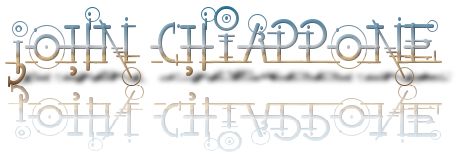Chapter:
INT |
1 |
2 |
3 |
4
|
5
|
6
|
7
|
8 |
9 |
10 |
11 |
12 |
13
Elements
of Art |
Principles
of Art
| Definitions
|
Guide
T
O H U M A N I T I E S
|
I
N T R O D U C T I O N

A R T & K N O W L E D G E
|
|
BRANCHES OF EDUCATION
|
|
HUMANITIES
-
Performing Arts
-
Visual
Arts
-
Architecture
-
Literature
-
History
-
Philosophy
-
Religion
-
Languages
and Linguistics
-
Jurisprudence (theory and philosophy of
law)
SOCIAL
SCIENCE
-
Sociology
-
Anthropology
-
Archaeology
-
Cultural
and Ethnic Studies
-
Economics
-
Gender
and Sexuality
-
Geography
-
Political
Science
-
Psychology
NATURAL
SCIENCE
-
Physics
-
Chemistry
-
Space
Sciences
-
Earth
Sciences
-
Life
Sciences
FORMAL
SCIENCES
-
Computer
Sciences
-
Logic
(also a branch of philosophy)
-
Mathematics
-
Statistics
PROFESSIONS & APPLIED SCIENCES
-
Design
-
Engineering
-
Education
-
Business
-
Forestry
and
Environmental Studies
-
Family
and Consumer Science
-
Health
Sciences
-
Journalism, Media, and Communications
-
Law
(jurisprudence is a humanities)
-
Library
and Museum Studies
-
Military
Sciences
-
Public
Administration
-
Social
Work
-
Transportation
-
Agriculture
|
Although we separate the
humanities from the sciences and math, it wasn't always that
way. Medieval scholars classified the humanities as studies
that were relevant to humans. The humanities included:
philosophy (the sciences were called natural philosophy),
math, and the arts. Theology and religion were rendered onto
God. As you can see above, we now consider Theology to be a
philosophy while religion is not, but both are included in
the humanities.
did you know that PhD stands for Doctor of Philosophy, and
lawyers have PhD degrees. In other countries they have the
title of Doctor, but in this country they don't.
The branches of philosophy include:
- Metaphysics is the study of the basic nature of reality.
Traditional branches are cosmology and ontology. Cosmology
is the study of the universe. Ontology is the general study
of reality, types of being, what can be said to exist, and
how they should be categorized.
- Epistemology is the study of the nature and scope of
knowledge. Skepticism is the belief that knowledge is
impossible.
- Ethics is moral theory. The main branches are applied
ethics, meta-ethics, and normative ethics. Meta-ethics asks
whether absolute moral truths exist, and how we can know
them. Normative ethics asks what act, or personality traits,
are good or bad.
- Political philosophy is the study of government. It
includes justice, law, and property.
- Aesthetics is concerned with art and beauty.
- Logic is the study of proper reasoning.
- Philosophy of mind deals with theory of mind. One of it's
main concerns is the mind body problem.
- Philosophy of language
- Theology is theory of God.
What is beauty?
(Aesthetics)
Is beauty an average?
read more
Conventions:
 |
This is the Chrysler Crossfire concept car. It
has a great sense of repetition. The production car
was built for Chrysler by Karmann of Germany - with
parts from Mercedes Benz .
The production car's design was slightly changed in
the production car because of conventions. What
change do you think they made. Click the picture for
more images. |
Painting Method
We start by stretching raw canvas on a wooden frame. The canvas
is painted with gesso - a primer. Lines are painted with a brush
because pencils crack the gesso, and years later those cracks
appear through the surface. The first layer of paint is thin,
sketchy, and spontaneous. We call this the underpainting. We
build thicker layers on top of thinner layers. We do not put
thinner layers on top of thicker layers because that also
promotes cracking. Oil paint can take over 7 days to dry, and
the paint needs to dry before a new layer can be applied. this
is why it can take months before an oil painting is finished.
Why do you suppose we use canvass as a surface to paint? Is it
just a custom?
[Answer]
Important Concepts
Underpainting:
An underpainting is
the first layer of paint that is applied in a sketchy manner.
Underpaintings are often monochromatic; the technique of
painting with shades of only one color is called Grisaille.
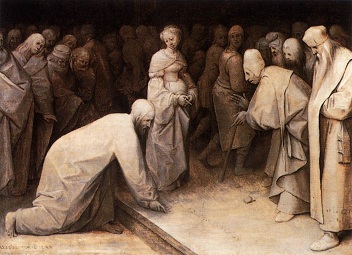
Christ and the Woman Taken in Adultery by Pieter Bruegel the
Elder
Impasto:
Impasto is a
painting technique where paint is laid on thickly. This
technique makes the painting less realistic, but gives it
texture.

Painterly:
A painting is
considered painterly when the brushstrokes are visible, and it
was painted in a free, and spontaneous manner. Examples:
Marla Olmstead
|
Aelita Andre Video
Linear:
A painting is
considered linear when the brushstrokes are not visible, and it
was painted in a precise, and controlled manner. Linear also
refers to sculpture that uses line, rope, wire etc, and it
refers to a kind of perspective that we will get to later.
Photorealism by Glennray Tutor |
John Baeder
Match the terms to
the painting:
PURPOSES OF ART
1. Provide a Record
2. To Express Feelings
3. To Reveal Metaphysical Truths
4. To see common things in uncommon ways - different
perspectives.
1. Provide a Record
Before
photography we recorded what people looked like by painting
them. The problem is that people want to be remembered as
looking better than they really did look. When creating a
record, should artists take liberties, and always create
beautiful paintings, or should they be accurate? This
etching is of a famous person. Do you know who this is?
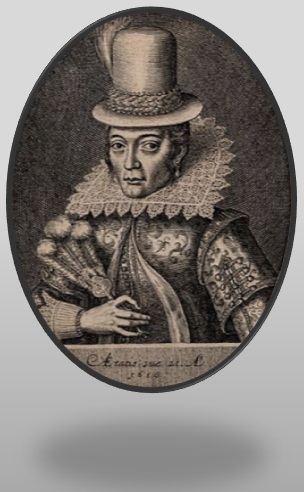
Click the picture for the answer.
Naturalist Illustrations:
Ernst Haeckel (1834 – 1919) was a
German naturalist,
philosopher, physician, and artist. He
discovered and named
thousands of species.
2: To Express Feelings:
Should we only depict good feelings?
Analyze this untitled poem by E. E.
Cummings (1894-1962):
Two people not in love
by Peter Fuss
Abdi Farah
-
Home
|
3 Bombs
|
Exhibition
David Alfaro Siqueiros
(1896 - 1974) was a Mexican painter. He,
Diego Rivera, and José Clemente Orozco
established Mexican Muralism. See
MOMA Collection
ABSTRACT
EXPRESSIONISM - p21
JACKSON POLLOCK
video
|
CREATE
Unknown Artist
Marco Grassi
SUSO
Abstract action drawing.
3. To Reveal Metaphysical Truths:
Metaphysics is a branch of philosophy where we ask questions
like: what is
real; what is the basic nature of reality; what is the cause
of all things? These
are all metaphysical questions. Philosophers in the West
have been attempting to answer the first question since the
ancient Greek philosopher Thales of Miletus (624-545 BCE)
asked it.
In epistemology we ask questions that pertain to knowledge.
These questions can change our view of reality. Does reason alter
belief, or does belief alter reason? In Man's Emerging Mind,
H. J. Berrill said:
| |
I think the statement you often hear that 'seeing is
believing' is one of the most misleading ones a man has ever
made, for you are more likely to see what you believe than
believe what you see. To see anything as it really exists is
about as hard an exercise of mind and eye as it is possible
to perform... .
Read More
|
|
Metaphysical, and epistemological, questions have lead philosophers to different visions
of reality - like paintings of Being hanging on some cosmic
wall. The most successful vision of reality belongs to
Democritus (460-360 BCE) and Leucippus. We know it as the
atomic theory of reality; reality consists of atoms moving
in a void. Atoms have properties in themselves like:
position, impenetrability, shape, weight, etc.; we call
these primary qualities. They also have the ability to cause
properties in us that are not in the atoms; atoms lack
color, smell, taste, odor, and temperature. In art this
vision is best portrayed by pointillism.
POINTILLISM
Georges Seurat

A
Sunday Afternoon on the Island of la Grande Jatte
|
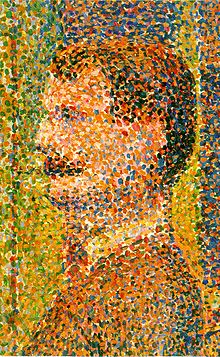
Detail of La Parade
|
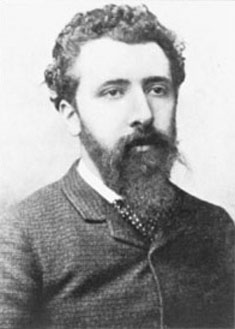
|
SURREALISM
(presentation)
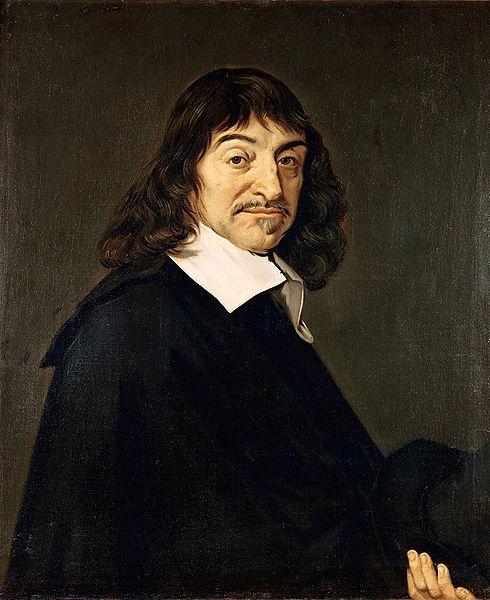
René Descartes
(1596 – 1650) was a French philosopher, and
mathematician. He is considered the father of modern
philosophy. His
Meditations on First Philosophy used a method of doubt
where he attempted to doubt all his beliefs, so he could
find one belief that was impossible to doubt (certain), and
could serve as the foundation to his philosophy - his
starting point. If he seems unreasonable to you, remember
that he wants his starting point to be certain - free of
even the most unreasonable doubt.
How do you know you're
not dreaming? How do you know you're not insane? How do you
know that an evil demon is not attempting to deceive you on
all your beliefs? These questions, although unreasonable to
some extent, lay waste the claim that we know anything for
certain, or do they?
In the second
meditation Descartes said:
| |
"Doubtless,
then, I exist, since I am deceived; and, let him deceive me
[an evil demon]
as he may, he can never bring it about that I am nothing, so
long as I shall be conscious that I am something. ... this proposition ... I am, I
exist, is necessarily true each time it is expressed by me,
or conceived in my mind." |
|
Cogito ergo sum. I think; Therefore I exist. Is impossible
to doubt, and is the starting point of modern philosophy,
but this starting point traps us in consciousness. This is
one of the great problems in philosophy. How do we get
outside ourselves to know that our perceptions are accurate
representations of the
real word. It is this problem that surrealism addresses. It
turns to the dream state as it's source of inspiration.
From Le Manifeste du Surréalisme, 1924
ANDRÉ BRETON
Surrealist Animation
Raymond Georges
Yves Tanguy,
1900–1955,
French painter.
Dali and Max Ernst:
Salvador Dali, 1904-1989,
Spanish
Max Ernst, 1891–1976, German painter, sculptor, and poet. He
is a pioneer of the Dada and Surrealist movements.
Rene Magritte,
1898-1967, Belgian Painter
John Locke – p20
P21 Out of chaos we create form –
TED
A Stroke of Insight
4: Different Perspective
DADA Art and Existentialism Philosophy:
(Art is not a
mirror; it's a hammer.)
The dada
movement began in Zürich Switzerland in 1916 as
a reaction to World War I. They believed that “Destruction
is also creation." Dada can best be defined as art without
rules. It focuses on the absurdity of existence,
irrationality, is countercultural, controversial, and
shocking.
Dadaism looks to existentialist philosophy for inspiration.
Starting with Søren Kierkegaard, the existentialist reacted
against a world at war, and accepted Descartes foundation of
philosophy as consciousness.
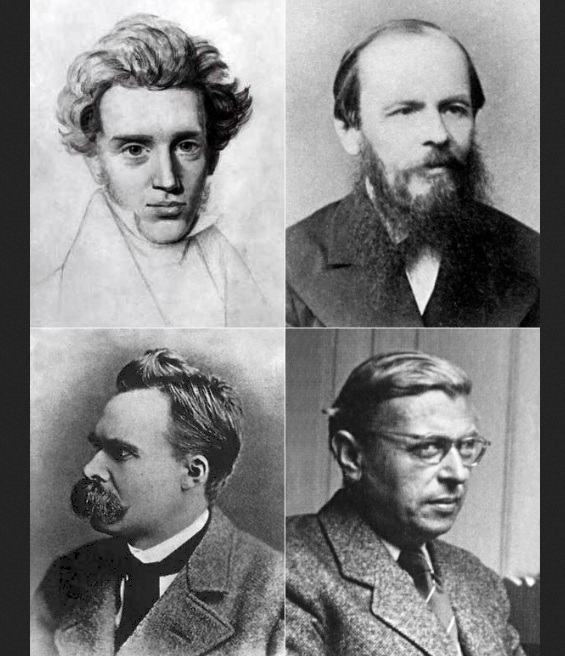
From left to right, top to bottom: Kierkegaard, Dostoyevsky,
Nietzsche, Sartre.
- Science and systematic philosophies are removed from
experience.
- No moral rule can serve as a complete guide for our
actions.
- Life is meaningless unless we define ourselves.
- We are defined by our actions.
- Be true to your nature; be authentic.

Fountain (1917) by Marcel Duchamp
Art is whatever is displayed as art.
Marcel Duchamp (1887
–1968) was a French artist whose work is most often
associated with the Dadaist and Surrealist movements. He
produced relatively few artworks. His output influenced the
development of post-World War I Western art. He advised
modern art collectors, such as Peggy Guggenheim and other
prominent figures, thereby helping to shape the tastes of
Western art during this period.
He said, “The creative
act is not performed by the artist alone; the spectator
brings the work in contact with the external world by
deciphering and interpreting its inner qualifications and
thus adds his contribution to the creative act.”
Write the purpose
of art to the left:
FUNCTIONS OF ART :
SOCIAL CHANGE
Dread Scott
Tayler's
What is the Proper Way to Display a US
Flag?
Banksy
www.youtube.com/watch?v=8GVs3BSxoOs
Warning - the above link has material that might be
considered offensive.
Igor Stravinsky -
THE RITE OF SPRING, 1912
Picasso
-
G U E R N
I C A
- In 1937 Nazis bombed the
Spanish town of Guernica during the Spanish Civil War. It
was the first aerial bombing of civilians in history.
- 11 feet tall by 25 feet long
– you feel dwarfed by it, and like you’re within the image.
- The painting is done in black, white, and grays to create
contrast.
- The horse dominates the
center, and represents the people.
Watch Pan’s
Labyrinth:
www.panslabyrinth.com
- The
bull symbolizes senseless suffering, farm animals
(Guernica’s a farming community), & God (the mother pleads,
& the bull ignores her.
-
Notice the man holding the flowers.
CRITICISM:

Gabriel Cornelius von
Max, 1840-1915
Monkeys as Judges of Art, 1889
Sporre points out that the experts
disagree, and that their criteria of what constitutes art
restricts creativity. When Picasso was asked what is art, he
responded by saying, "what isn't art?"
 Dr.
Neil de Grasse Tyson had the courage to disagree with
accepted norms, and push our understanding. Up until
recently it was an established fact that Pluto is a planet -
not any more.
Dr.
Neil de Grasse Tyson had the courage to disagree with
accepted norms, and push our understanding. Up until
recently it was an established fact that Pluto is a planet -
not any more.
Read more:
Pluto's Not a Planet? Only in
New York
Is
science a humanities?
Place these levels of education in their proper order; from
where students start to the highest level of education:
- Deliberately
bias yourself. When you examine the work of others,
you give them the strongest interpretation possible. Women tend
to do this - according to a study at Wellesley College.
- You do
exactly what your teachers want.
- You
believe that an
education consists of memorizing facts
established by experts.
- You
objectively examine ideas, are skeptical, and
unbiased. You are
aware of your own thinking and mistakes, and the thinking and
errors of others. Everything is up for debate. Men tend to do this.
- Realizing that the experts
disagree.
Knowledge becomes a matter of
opinion or gut instinct.
Click here for the answers.
 PLATO
(427-348 BCE) was the first art critic. P27 BCE means before
the common era. He believed in different levels of reality,
and but art at the bottom because it’s a copy
(Art is a Mirror). If art is
not viewed as a mirror, what is it then?
PLATO
(427-348 BCE) was the first art critic. P27 BCE means before
the common era. He believed in different levels of reality,
and but art at the bottom because it’s a copy
(Art is a Mirror). If art is
not viewed as a mirror, what is it then?
Plato believed in censoring art. We don’t know all ends, so
we shouldn’t tamper with convention. We shouldn't glorify
violence and vice -
Collateral Club Scene with music by Paul Oakenfold.
Without deviation from the norm, progress is not possible."
- Frank Zappa
Guess Who's Coming to Dinner
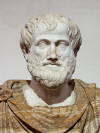 ARISTOTLE
(384-382 BCE)
was Plato’s student. Aristotle's
Poetics
is the earliest-surviving work of drama and literary theory.
It covers poetry, drama, comedy, and tragedy.
ARISTOTLE
(384-382 BCE)
was Plato’s student. Aristotle's
Poetics
is the earliest-surviving work of drama and literary theory.
It covers poetry, drama, comedy, and tragedy.
DECONSTRUCTION
This
theory of art criticism was advanced by the philosopher
Jacques Derrida. He believed that an analysis of any artwork
would yield conflicting meanings. The meaning of a work
arises from the artist and viewer, so there is no absolute
meaning, facts, or truths in art. There are only
interpretations.
FORMAL
CRITICISM
Formal
criticism does not consider any external information. The
work must stand on it's own. This ignores symbolisms that
point to things happening in the world.
READ MORE
Criteria:
Artisanship
Clarity
Coherence
Interest
Is it unique?
CONTEXTUAL CRITICISM
This
includes external factors.
Criteria:
Does the artist
have something to say?
How well does she
say it?
Is it worth saying?
Does it make you
think or feel?
